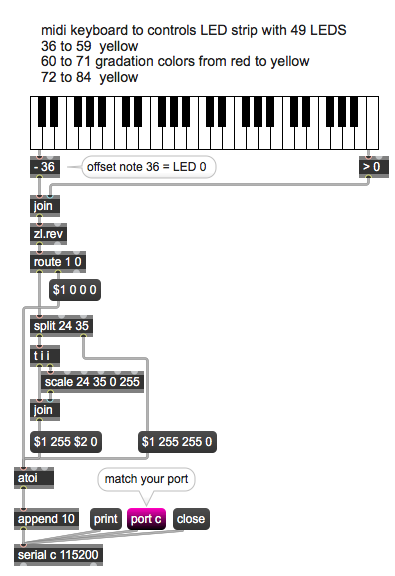How to address an LEDs strip APA106 MAX patch to Arduino
Hello!
The patch is a midi keyboard to control a digital LED strip where there are 49 LEDS. From 36 to 59 (bass line) yellow, from 60 to 71 (gradation colors from red to yellow and the data is a MARKOV output) and from 72 to 84 just yellow again. Each LED lit up the color based on its corresponding MIDI note based on what note was pressed.
I would appreciate if any of you could help me with this issue.
Which issue are you actually facing? If you're wondering how to do what you want, you'll need to make a Max patch to format and send data over to your Arduino through the [serial] object, and make the Arduino code to receive, decode and interpret this data and drive the leds.
If you search for "LED strip" in the forum, you'll find several examples with Max patch and Arduino code. Seems like the APA106 LEDs are compatible with Adafruit's NeoPixels API, so you can add "NeoPixels" to your search to get more specific result.
dear TFL.
Thank you.
Yes. This is an old work being updated for my thesis and the first patch is this one attached now. The new patch is a max.proj.
both are not working using the path you have suggested. In this old patch, the LEDs lights only between the C 60 and B 71, the rest remain off. The Arduino IDE is attached as well.
And yes, I already made a research in the forum concerning LED strip.
I am using an ESP32 and FastLED library
LED strips
The Arduino code is missing from your post.
Also, no need to post your entire patch when you struggle with only a small part of it. I had to search for "serial" in the patch to know where to look at, but then I'm still clueless about how the data in the two [coll] objects is supposed to drive your led strip.
Many thanks TFL,
One Coll object reads the melody and the other the harmony. The file has to be in just one score. Thank you for the tip when sharing the patch.
#include "FastLED.h"
#include <Arduino.h>
#define LED_PIN 23
#define NUM_LEDS 49
#define BRIGHTNESS 32
#define LED_TYPE APA106
#define COLOR_ORDER GRB
CRGB leds[NUM_LEDS];
#define UPDATES_PER_SECOND 100
//CRGBPalette16 currentPalette;
TBlendType currentBlending;
//extern CRGBPalette16 myRedWhiteBluePalette;
//extern const TProgmemPalette16 myRedWhiteBluePalette_p PROGMEM;
void rainbow_wave(uint8_t thisSpeed, uint8_t deltaHue) { // The fill_rainbow call doesn't support brightness levels.
// uint8_t thisHue = beatsin8(thisSpeed,0,255); // A simple rainbow wave.
uint8_t thisHue = beat8(thisSpeed,255); // A simple rainbow march.
fill_rainbow(leds, NUM_LEDS, thisHue, deltaHue); // Use FastLED's fill_rainbow routine.
} // rainbow_wave()
void setup() {
Serial.begin(9600);
delay( 1000 ); // power-up safety delay
FastLED.addLeds<LED_TYPE, LED_PIN, COLOR_ORDER>(leds, NUM_LEDS).setCorrection( TypicalLEDStrip );
FastLED.setBrightness( BRIGHTNESS );
//currentPalette = RainbowColors_p;
currentBlending = LINEARBLEND;
//FastLED.clear();
//FastLED.show();
//Serial0.begin(115200);
//Serial0.println("The device started, now you can pair it with bluetooth!");
fill_solid(leds, NUM_LEDS, CRGB(255,0,0)); // fill red
FastLED.show();
delay(200);
fill_solid(leds, NUM_LEDS, CRGB(0,255,0)); // fill green
FastLED.show();
delay(200);
fill_solid(leds, NUM_LEDS, CRGB(0,0,255)); // fill blue
FastLED.show();
delay(200);
FastLED.clear();
FastLED.show();
}
int started = 0;
int dot=0, color=0;
void loop() {
if(!started){
rainbow_wave(10, 10); // Speed, delta hue values.
FastLED.show();
}
if (Serial.available()) {
started = 1;
// Read the incoming byte
byte incomingByte = Serial.read();
// Assign the byte to the appropriate color component of the current LED
if (color == 0) {
leds[dot].r = incomingByte;
} else if (color == 1) {
leds[dot].g = incomingByte;
} else { // color == 2
leds[dot].b = incomingByte;
}
color = (color + 1) % 3; // Move to the next color component
if(color == 0){ // If we just finished the blue component (color was 2 before the increment)
dot = (dot + 1) % NUM_LEDS; // Move to the next LED
}
FastLED.show();
}
// clear this led for the next time around the loop
//delay(20);
}
That should be much simpler.
You use predefined colors and no velocity based intensity.
So all you need is LED id and color number
for note on or black for note off.
2 bytes only
Remove delays from loop and increase
baud rate
That's all
I thank you for your kindness.
Maybe there is something in wrong with the max patch.
I changed the baud rate to 115200 and removed the delays in Arduino IDE.
That is what the console says:
print: 255 255 0 90
print: 255 255 0 54
status: write 13
status: write 12
the status write keep on repeating the same numbers (12, 13)
I had and still have no time to debug your patch.
You need only 1 serial object.
And you need a plan how to address the LEDs.
From what I understood from your initial post,
nothing in that arduino code and max patch
do that : light a LED depending on note number with specified color
and turn LED off when note gets turned off.
this is all you need to light that 49 LEDS from max.

replace kslider with output from seq

...
in Arduino parse LED number and 3 colors.
Genial! I can hardly wait to get home and give it a try.
Thank you so much!!!
